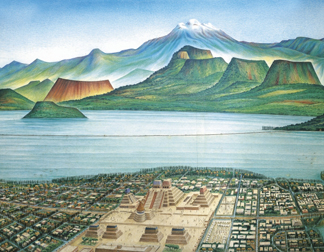Published 21/05/2016
Explore Bridgeman collections that illustrate how pre-Columbian societies lived and flourished before the Spanish colonization of the Americas.


|
The term Mesoamerica describes a region that included Mexico, Guatemala, Belize, El Salvador, Honduras, Nicaragua and Costa Rica. Cultures in this region were similar to each other in a variety of ways, including: a reliance on the cultivation of maize, the use of two calendars (a 260-day ritual version and a 365-day solar version), vigesimal number systems (based on the number 20), pictographic and hieroglyphic writing systems, the practice of sacrifice, and similar linguistic and grammatical qualities. While there were many city-states vying for power over the 3,000 year period before European discovery, today we consider there to have been five major civilizations: the Olmec, Teotihuacan, Toltec, Aztec (also known as the Mexica or Triple Alliance) and the Maya. |
| The typical Mesoamerican citizen lived in highly communal hunter-gatherer or agrarian groups. Due to diverse ecological conditions between communities, the exchange of goods was an essential activity, which required strong leadership to coordinate. This leadership also made it possible to organize large groups of people into hierarchies to drive important aspects of society such as building and labor, trade, farming, military and production of goods. This, in turn, allowed for tremendous growth of cities. At it's peak, the Aztec capital of Tenochtitlan, today the site of Mexico City, was one of the largest cities in the world with a population of more than 300,000. Tenochtitlan's marketplacewas a bustling metropolis of it's own with more than 60,000 people trading such goods as corn, tropical fruit, beans, obsidian, jade, cotton, yucca, agave, animal skins and feathers. |

|

|
Rites, Rituals & Recreation All pre-Columbian cultures practiced various forms of ritual sacrifice. The self-inflicted variety, such as bloodletting, could be practiced by people in all classes, while highly ceremonial human sacrifice was part of an elaborate social and religious rite, reserved for the elite. An underlying cultural belief was that ongoing sacrifice sustained the Universe. To be sacrificed was the 'highest' form of death and victims were honored posthumously as relics of the gods. These cultures also had a vast understanding of astronomical cycles and planets, particularly the sun, moon and Venus. Many observatories have been uncovered, such as El Ceibal in Guatemala. And it is thought that the organization of architectural sites were based on precise astronomical calculations. |
|
The sun and moon were also important to Mesoamerican mythology. The world was thought of in two parts: a day world protected by the sun and a night world overseen by the moon. Elaborate calendars were the basis for this worldview, dictating symbolism and ritual aspecs for seasons, compass points, animals and weather. Another common feature of these societies was a ballgame called 'Tlachthli' which was played in courts specifically built for the purpose. The game, a distant cousin of racquetball, was thought to be played casually by all members of society as recreation, but games would often be ritual events featuring human sacrifice. The aim was to keep the ball in play by striking it with your hips and against the arena walls and stone hoops. Players often wore stylized yokes that pinned one arm to the player's side. A modern version of the game, called Ulama, is played by some indigenous groups even today. |

|

|
Aztec Codex Borbonicus, detail depicting Quetzalcoatl (good/day) and Tezcatlipoca (evil/night)/ Bibliotheque de l'Assemblee Nationale, Paris |
Bridgeman represents many collections with a variety of pre-Columbian material, from reconstructions and historic renderings and artifacts, to archaeology and architecture. De Agostini Picture Library, an Italian publishing archive, and the National Geographic Image Collection have unique 20th century recreations of daily life and myths, while the Lowe Art Museum, Boltin Picture Library and the Sainsbury Centre for Visual Arts have a wealth of artifacts, and French photographer, Jean-Pierre Courau, specializes in photographing the archaeological sites in the region.
If you need images for a current project, email us your research request and we'll put together a selection for you, or help you source that hard to find image through one of our partners.


